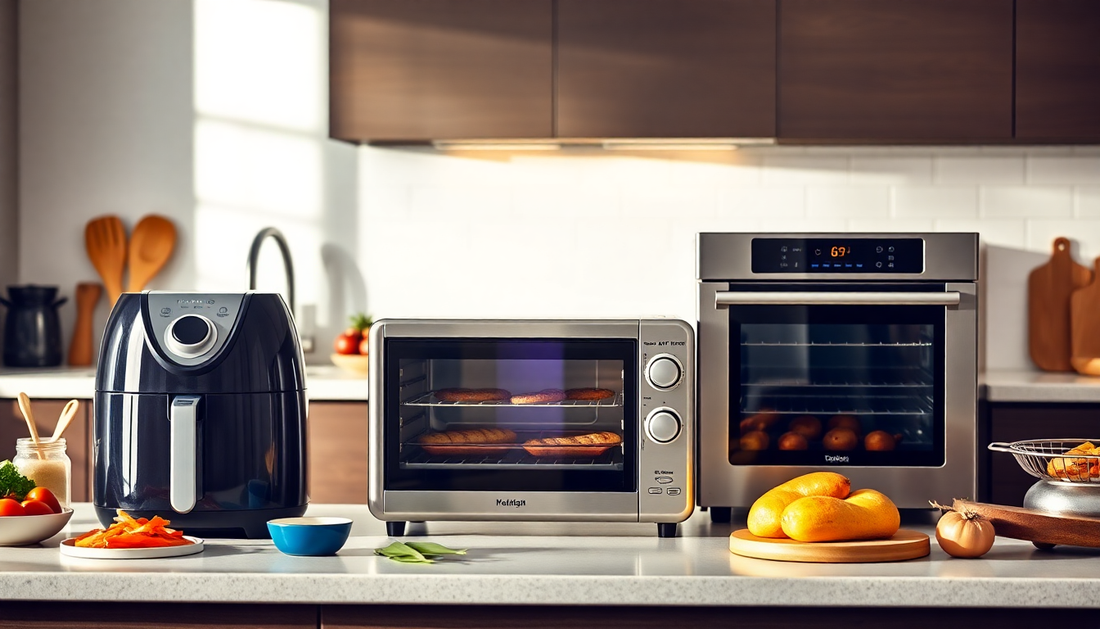
Air Fryer vs. Toaster Oven vs. Traditional Oven: Which One Should You Buy?
Share
In the ever-evolving world of kitchen appliances, the battle for the perfect cooking companion has intensified. As home cooks, we're constantly faced with the dilemma of choosing between the latest trendy gadgets and the tried-and-true classics. Today, we'll dive into the pros and cons of three popular cooking tools: the air fryer, the toaster oven, and the traditional oven, to help you determine which one should take center stage in your kitchen.
The Air Fryer: The Trendy Option
The air fryer has taken the culinary world by storm, promising healthier and crispier results with a fraction of the oil used in traditional frying. These compact appliances work by circulating hot air around the food, creating a crispy exterior while locking in the juices. Air fryers are particularly adept at cooking up quick and easy meals, from french fries and chicken wings to roasted vegetables and even baked goods.
The main advantages of an air fryer include:
- Healthier cooking: By using little to no oil, air fryers significantly reduce the amount of fat and calories in your meals.
- Faster cooking times: The rapid air circulation allows for quicker cooking compared to a traditional oven.
- Versatility: Air fryers can handle a wide range of dishes, from snacks to main courses.
- Easy cleanup: The compact design and lack of oil make air fryers a breeze to clean.
However, air fryers do have their limitations:
- Limited capacity: Depending on the model, air fryers can only accommodate small to medium-sized portions, making them less suitable for large families or entertaining.
- Specialized cooking: While air fryers excel at crisping and browning, they may not be the best choice for certain cooking techniques, such as baking or roasting larger items.
- Higher energy consumption: Air fryers can use more energy per cooking session compared to a toaster oven or traditional oven.
The Toaster Oven: The Versatile Contender
The humble toaster oven has come a long way from its humble beginnings as a simple bread-toasting appliance. Today's toaster ovens offer a wide range of features and functionalities, making them a formidable competitor in the kitchen.
Toaster ovens are known for their versatility, as they can handle a variety of cooking tasks, from toasting and baking to broiling and even small-scale roasting. Their compact size makes them an excellent choice for small kitchens or when you need to supplement your main oven.
The key advantages of a toaster oven include:
- Versatility: Toaster ovens can tackle a wide range of cooking tasks, from simple toast to more complex dishes.
- Energy efficiency: Toaster ovens use less energy than a traditional oven, making them a more eco-friendly and cost-effective option.
- Convenient size: The compact design of toaster ovens makes them ideal for small spaces or when you need to cook a smaller portion.
- Faster preheating: Toaster ovens typically preheat much faster than a traditional oven, saving you time.
While toaster ovens are highly versatile, they do have some limitations:
- Limited capacity: Toaster ovens are generally smaller than traditional ovens, so they may not be suitable for large-scale cooking or baking.
- Uneven heating: Depending on the model, toaster ovens may not provide as even and consistent heat distribution as a traditional oven.
- Potential for smoke or odors: Some toaster oven models may produce more smoke or strong odors during cooking, especially when broiling or baking.
The Traditional Oven: The Classic Choice
The traditional oven remains the gold standard for home cooking, offering unparalleled cooking capabilities and a familiar, time-tested design. These full-sized appliances are the go-to choice for serious home chefs, providing the space and power to handle a wide range of culinary tasks.
The key strengths of a traditional oven include:
- Cooking versatility: Traditional ovens can handle everything from baking and roasting to broiling and even slow cooking, making them the most versatile option.
- Consistent heat distribution: The larger size and advanced heating elements of traditional ovens ensure even and consistent heat throughout the cooking chamber.
- Ample capacity: Traditional ovens offer the largest cooking space, making them ideal for large meals, holiday gatherings, or batch cooking.
- Familiarity: The traditional oven design is well-known and comfortable for most home cooks, providing a sense of familiarity and confidence in the cooking process.
However, traditional ovens do have some drawbacks:
- Higher energy consumption: Traditional ovens generally use more energy than their smaller counterparts, which can result in higher utility bills.
- Longer preheating and cooking times: The larger size of a traditional oven means it takes longer to preheat and cook food compared to a toaster oven or air fryer.
- Larger footprint: Traditional ovens require more counter or cabinet space, which can be a consideration in smaller kitchens.
Comparative Analysis: Which One Should You Buy?
When it comes to choosing the right cooking appliance for your kitchen, several factors come into play. Let's take a closer look at how these three options stack up in terms of energy efficiency, cooking time, food quality, and cost considerations.
Energy Efficiency:
- Air fryers are generally the most energy-efficient, using less power than a traditional oven.
- Toaster ovens are also more energy-efficient than traditional ovens, thanks to their smaller size and faster preheating times.
- Traditional ovens, while the most powerful, tend to consume the most energy per cooking session.
Cooking Time:
- Air fryers excel at quick cooking, with their rapid air circulation and smaller capacity.
- Toaster ovens are also relatively fast, with shorter preheating times compared to traditional ovens.
- Traditional ovens take the longest to preheat and cook, but they can handle larger quantities of food at once.
Food Quality:
- Air fryers produce crispy, crunchy results, particularly for fried or roasted foods.
- Toaster ovens can deliver excellent results for baking, broiling, and small-scale roasting.
- Traditional ovens offer the most versatility, allowing for a wide range of cooking techniques and producing high-quality results across the board.
Cost Considerations:
- Air fryers are generally the most affordable option, with prices ranging from $50 to $200 for a quality model.
- Toaster ovens fall in the middle, with prices typically between $100 and $300, depending on the features and size.
- Traditional ovens are the most expensive, with prices starting around $500 and going up significantly for high-end models.
Which One Should You Buy?
When it comes to choosing the right cooking appliance for your kitchen, the decision ultimately comes down to your specific needs, cooking style, and budget.
If you're looking for a quick and healthy way to prepare small to medium-sized portions, an air fryer might be the perfect fit. It's an excellent choice for busy weeknights or when you want to whip up a crispy snack without the guilt.
For those with a bit more counter space and a desire for greater versatility, a toaster oven could be the ideal compromise. It offers the ability to handle a wider range of cooking tasks while still being more energy-efficient and compact than a traditional oven.
However, if you're a serious home cook who enjoys tackling large-scale meals, hosting gatherings, or exploring a wide range of cooking techniques, a traditional oven is likely the best investment. While it may require more energy and space, the traditional oven's unparalleled cooking capabilities and consistent results make it a kitchen staple for many.
Ultimately, the choice between an air fryer, toaster oven, and traditional oven comes down to your specific needs, budget, and personal cooking preferences. By weighing the pros and cons of each option, you can make an informed decision that will elevate your home cooking experience and bring joy to your kitchen.
